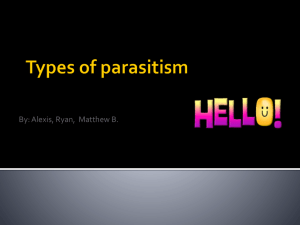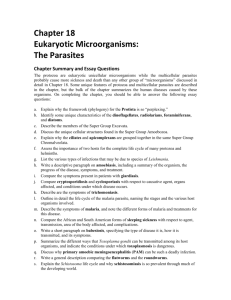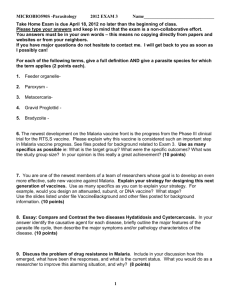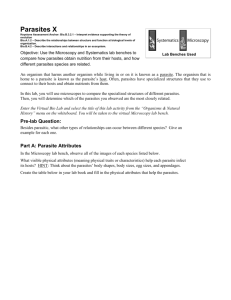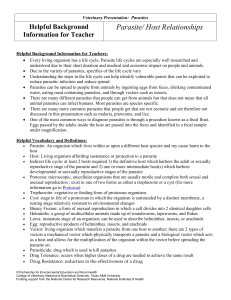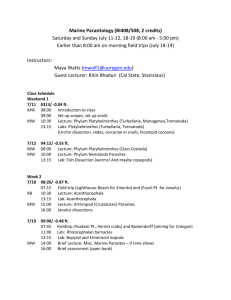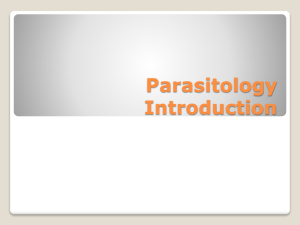III. Basic Principles, Chapter 2 (BLY 459, 2011) A. ZOONOSES 1.
advertisement
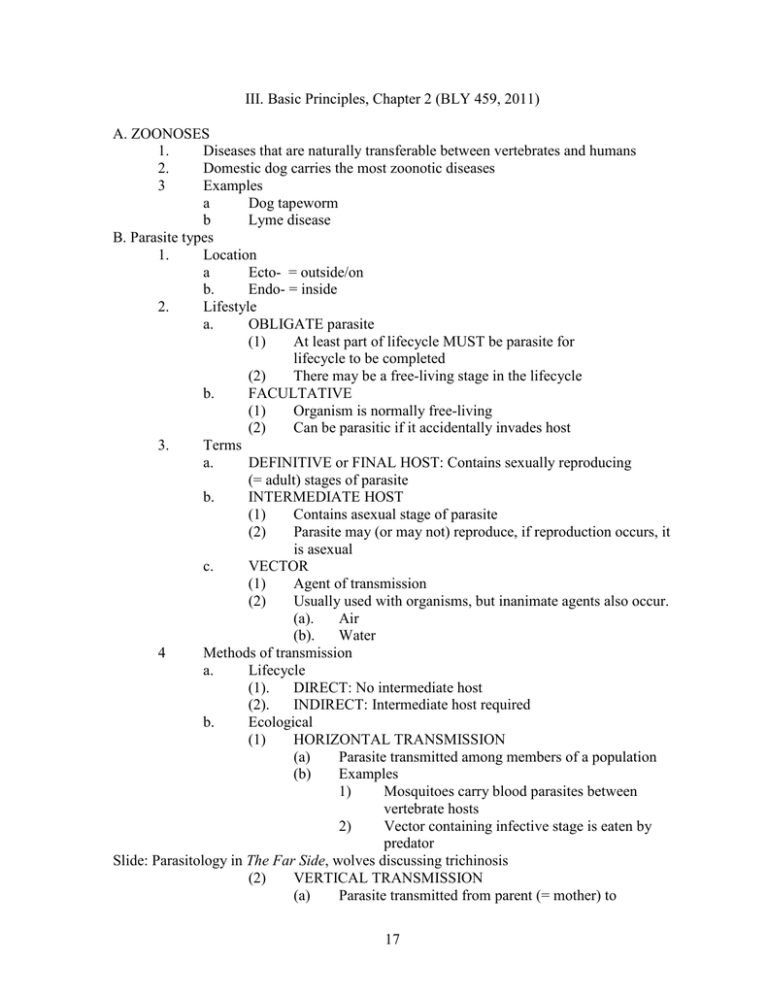
III. Basic Principles, Chapter 2 (BLY 459, 2011) A. ZOONOSES 1. Diseases that are naturally transferable between vertebrates and humans 2. Domestic dog carries the most zoonotic diseases 3 Examples a Dog tapeworm b Lyme disease B. Parasite types 1. Location a Ecto- = outside/on b. Endo- = inside 2. Lifestyle a. OBLIGATE parasite (1) At least part of lifecycle MUST be parasite for lifecycle to be completed (2) There may be a free-living stage in the lifecycle b. FACULTATIVE (1) Organism is normally free-living (2) Can be parasitic if it accidentally invades host 3. Terms a. DEFINITIVE or FINAL HOST: Contains sexually reproducing (= adult) stages of parasite b. INTERMEDIATE HOST (1) Contains asexual stage of parasite (2) Parasite may (or may not) reproduce, if reproduction occurs, it is asexual c. VECTOR (1) Agent of transmission (2) Usually used with organisms, but inanimate agents also occur. (a). Air (b). Water 4 Methods of transmission a. Lifecycle (1). DIRECT: No intermediate host (2). INDIRECT: Intermediate host required b. Ecological (1) HORIZONTAL TRANSMISSION (a) Parasite transmitted among members of a population (b) Examples 1) Mosquitoes carry blood parasites between vertebrate hosts 2) Vector containing infective stage is eaten by predator Slide: Parasitology in The Far Side, wolves discussing trichinosis (2) VERTICAL TRANSMISSION (a) Parasite transmitted from parent (= mother) to 17 offspring (b) Examples i Toxocara worms cross placenta and enter puppies ii Anclyostoma worms in mothers milk (3) RESERVOIR HOST (a) A local animal species that harbors a human parasite (b) Concept is important in eradication campaigns (c) Examples i Rats w/ trichinosis ii Monkeys w/ malaria c. PARATENESIS (1) Definition (a) Passage of an infective larva by a transport or paratenic host to another intermediate host. (b) Larva does not develop into an adult in the paratenic host, but it remains alive & infective (c) Paratenic host neither favors nor hinders development of parasite, in other words, the parasite neither reproduces nor does it metamorphose into the next developmental stage of its life-cycle (2) Ecological implications (a) Results in numerous species in an ecosystem being infected by the identical stage of one parasite species. (b) Strategy is effective in… i. …increasing the range/distribution of a parasite ii …withstanding the local extinction of an intermediate host (3) Commonly seen in Nematoda & Acanthocephala Slide: Paratenesis Example: Adult nematode species found in rat lungs has larvae that can infect humans (4) Example of the rat lungworm Angiostrongylus cantonensis (a) Humans are at risk of acquiring larvae if they eat uncooked snails that harbor lungworm larvae (b) Humans are NOT part of the normal life-cycle (c) Invasive apple snails can serve as vectors for rat lungworm i Appeared in Louisiana 1987 ii Appeared in Mobile Municipal Park 2007-08 (d) Rat lungworm now present in Louisiana, but not seen in apples snails from Langan Park in 2010 Series of slides concerning Apple Snail Invasion of Mobile’s Municipal Park and the potential for paratenic infection of humans by rat lungworm. C. Evolution of virulent vs. benign (= attenuated) diseases 1. Basic concepts of evolution a. Individuals within populations have different traits = variation 18 (1) (2) Mutation creates new genes Crossing over & independent assortment during meiosis create new associations/combinations of different genes b. Genes enabling bearers to have more offspring become common in gene pool (1) Less than 1% of all organisms that are born ever reproduce Slide: Biology in The Far Side Praying mantis lecturing students (2) Maladaptive genes REMOVED from gene pool of population c. Reproductively isolated groups eventually split/evolve into new sibling species d. Mechanisms (1) NATURAL SELECTION (a) Genes removed from population (b) Death before reproduction (2) SEXUAL SELECTION (a) Females often choose the males (b) May lead to exaggerated traits (= bright plumage) that increase predation risk for male 2. Old hypothesis: Well-adapted parasites are benign a. Logic: If a parasite kills its host, it kills itself; thus, natural selection removes virulent genes from parasite populations b. Benign parasite strains have more offspring than virulent ones, because they live longer c. Explanations of documented exceptions (1) Evolution will select for traits in parasites that increase the likelihood that their intermediate hosts will be killed by predators that serve as the next host of the life-cycle, (2) Virulent parasites such as malaria only “recently” (in evolutionary time) switched to human hosts, i.e. there has not been enough time for malaria to have adapted to humans. 3. New hypothesis: Evolution will select for virulent parasites if negative effects on parasite, resulting from a shorter lifespan, have minor effect upon parasite transmission a. Pivotal question: Does parasite transmission require hosts to move? (1) If yes, then benign strains have more offspring (a) Common cold virus (b) Malaria in mosquitoes (2) If no, the parasite strains that produce the most offspring are those that consume host metabolic reserves most aggressively (= kill host) (a) Parasites spread by insects (b) Malaria in humans (c) Intermediate hosts b. Vertical transmission (1) Host exploitation reduces survival chances of offspring of both host & parasite (2) Benign parasites predicted 19 4. Experimental tests of evolutionary principles a. Natural Field Experiments: Repeated appearance of drug resistant parasites b. Virulence of parasitic organisms over generations is affected by lab maintenance procedures (1) Artificial infection of hosts in lab (= w/o using the vector) when old lab hosts get sick results in … (a) Virulence increasing in lab hosts (b) Decrease in ability of parasite to live in the vector (2) If parasites are maintained in vitro or in hosts not encountered in the wild, parasites lose ability to infect wild-type hosts. Slide: Development of both virulence as well as attenuation of parasite strains maintained for generations in the lab is predicted by evolutionary theory [Ebert, D. 1998, Science 282:1432-1435] 20



